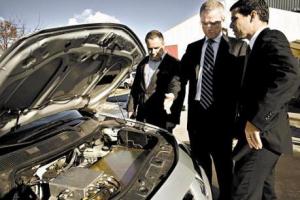This is my third blog posting on E.Factor about the subject luxury. In my previous blog posting on E.Factor I tried to start a discussion about the definition of ‘luxury' and present my personal definition of this relative term.
In this blog posting I want to discuss eCommerce in relation to luxury, hence the title: "To eCommerce or not to eCommerce?"
It has been a decade since the Internet Bubble and still only a few luxury players fully operate eCommerce Sales Channels. This is beyond my grasp. Therefore I am one of the founders of ILEA - International Luxury Ecommerce Association (www.LuxuryEcommerce.org). I want to start with my own situation/case and explain what made me co-found this non-profit association.
I am active as an entrepreneur in the Luxury Industry since 1998 and since that year I have been trying to sell luxury goods via internet (who used the term eCommerce back then?). Without succes... Until last year. With our family company Ace Jewelers Group we had the honor to launch the first authorized luxury ecommerce website in the Netherlands that sells: watches, jewelry, diamonds, sunglasses and accessoires (www.AceJewelers.com). I hear you thinking: "Nothing special about that, even Amazon sells these items for year." That is correct, but up until 2009 no luxury brand in our industry authorized online sales. All the items that seemed to be for sale online were either: fake, stolen, pre-owned, without warranty or from black markets. Most of the luxury brands (also fashion brands) were opposed eCommerce. Not many brands had a clear answer why, but Karl Lagerfeld – who is the artistic director of Chanel and also designs for Italian fashion house Fendi, a unit of LVMH – said that the Internet does not convey "the unique feel and sophistication of luxury materials, refined tailoring and extraordinary attention to detail found in luxury fashion." He added that shopping for high fashion required a "multi-sensory environment". For many luxury companies, the Internet is traditionally associated with cheap knock-offs sold on auction sites. The Internet can make it harder to know who the actual vendor of a product is. "This leads to fears of cheap copies and heavy discounting," says Bernstein Research luxury goods analyst Luca Solca (Source: Wall Street Journal, 11-2-2009).
I understand where Lagerfeld is coming from, but if you look at the technological development in the last 10 years and how the society and consumer behaviour has changed, I do not agree. The consumer of today wants: convenience, quality, service and instant satisfaction (at a low price). This is definitely the case for luxury purchases. I agree with Lagerfeld that for high fashion and other physical products consumers will often (not always) will want to feel, touch, see, smell and/or try-on the product before purchasing it. Therefore I truly believe in multichannel retail/cross-channel strategies for luxury brands, the so-called Golden Triangle/combination of: Retail, Etail and Concierge Service (Back-Office/eFullfilment). For some industries I truly believe retail is over (think of travel agents, book stores, video rental stores, etc). But for Luxury Goods/Services (please read previous blog item what luxury is), I don't believe stores will ever disappear. Never say never, but I do believe the role/task of a store will change. Stores will have to change their function of high speed sales outlet to brand experience centers. I find the Apple Stores one of the best examples.
Going back to our case, like Lagerfeld, most of the Swiss watch brands and international jewelry brands we represent in our stores, were and most of them are still opposed to eCommerce. Ace Jewelers have been online since 1998, but never received autorisation to sell the brands we officially represent online. In 2008 we decided to change our strategy of a pure retailer to a cross-channel (r)etailer. We founded Ace Online and we operated it as our fourth store within the Ace Jewelers Group. We have a dedicated Concierge Service that replies to all e-mails within 24 hours and they answer phone calls and incoming chats on the spot. We do not outsource any service and all staff members are trained within our industry and actually know what they are talking about. The Concierge Service is the bridge between our eBoutique and the physical stores. We truly moved to a cross-channel operation. Next month it is going to be a year that we operate full power... Maybe I will blog about the experiences in a future posting.
Today we can proudly say we are the first and only retailer in the world that can sell IWC watches and Baume & Mercier watches online. We are also the first company in the world to apply Augmented Reality in the jewelry industry (you can try on a diamond ring in front of your own computer). The luxury brands are slowly changing their strategies and experimenting with eCommerce. But, a lot of brands are still very much opposed. Breitling for example strictly forbids us to present even a picture of a watch on our website. This is one of the major reasons for us to participate in the foundation of a non-profit organisation like ILEA. The International Luxury Ecommerce Association was founded to create a Think Tank for everything that is linked to Luxury & Ecommerce. I always summurize it: "We want to turn all the non-believers of eCommerce into believers." Hereby I want to invite all believer AND especially all non-believers to become a member and participate in this enduring discussion via: www.LuxuryEcommerce.org.
I want to conclude this blog posting by saying that I don't believe we should even wonder IF we should progress with eCommerce... The question should be: "To eCommerce or to mCommerce"! Maybe a good title for a future blog posting 😉




